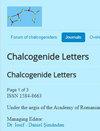光电子学用掺杂镍的硫化铜薄膜:结构、光学和磁特性
IF 1.3
4区 材料科学
Q4 MATERIALS SCIENCE, MULTIDISCIPLINARY
引用次数: 0
摘要
硫化铜纳米颗粒在各个领域有着广泛的应用,提高其物理性能是人们迫切需要的。在这项研究中,我们研究了镍浓度对cu纳米颗粒结构、光学和磁性的影响。通过x射线衍射(XRD)表征了Cu1-xNixS (x = 0.00, 0.02, 0.04, 0.06, 0.08和0.10)的结构性质,证实了所有样品都具有单一的六方相。利用能量色散x射线技术(EDAX)研究了Cu1-xNixS的元素分析。XPS研究揭示了Cu0.94Ni0.06S纳米颗粒中Cu、Ni和S的价态,以及表面氧化。利用紫外-可见-近红外双光束分光光度计在400 ~ 1000 nm波长范围内对薄膜的吸光度光谱进行了计算。cu和Ni掺杂cu样品的光学带隙随着Ni浓度的升高而减小。磁性研究(使用M-H曲线)表明,2%和4% ni掺杂的cu纳米颗粒在室温下表现出强铁磁性,并向顺磁性转变。这些结果表明,使用ni掺杂的cu纳米颗粒制造自旋电子器件具有潜力。本文章由计算机程序翻译,如有差异,请以英文原文为准。
Films of copper sulphide doped with nickel for optoelectronics: structural, optical, and magnetic characteristics
Copper sulfide nanoparticles have a wide range of applications in various fields, and improving their physical properties is highly desirable. In this study, we investigate the influence of nickel concentrations on the structural, optical, and magnetic characteristics of CuS nanoparticles. The structural properties of Cu1-xNixS (x = 0.00, 0.02, 0.04, 0.06, 0.08, and 0.10) were demonstrated using X-ray diffraction (XRD), which confirmed that all samples have a single hexagonal phase. The Energy Dispersive X-ray Technique (EDAX) was used to investigate the elemental analysis of Cu1-xNixS. The XPS study revealed the valence states of Cu, Ni, and S in the Cu0.94Ni0.06S nanoparticles, as well as surface oxidation. The optical characteristics were calculated based on the absorbance optical spectra of the films using a UV-vis-NIR double-beam spectrophotometer in the wavelength range of 400–1000 nm. The optical band gap for CuS and Ni-doped CuS samples decreases as the Ni concentration rises. Magnetic studies (using the M-H curve) demonstrate that 2% and 4% Ni-doped CuS nanoparticles exhibit strong ferromagnetism at ambient temperature and transition to a paramagnetic nature. These results suggest the potential of creating spintronic devices using Ni-doped CuS nanoparticles.
求助全文
通过发布文献求助,成功后即可免费获取论文全文。
去求助
来源期刊

Chalcogenide Letters
MATERIALS SCIENCE, MULTIDISCIPLINARY-PHYSICS, APPLIED
CiteScore
1.80
自引率
20.00%
发文量
86
审稿时长
1 months
期刊介绍:
Chalcogenide Letters (CHL) has the aim to publish rapidly papers in chalcogenide field of research and
appears with twelve issues per year. The journal is open to letters, short communications and breakings news
inserted as Short Notes, in the field of chalcogenide materials either amorphous or crystalline. Short papers in
structure, properties and applications, as well as those covering special properties in nano-structured
chalcogenides are admitted.
 求助内容:
求助内容: 应助结果提醒方式:
应助结果提醒方式:


